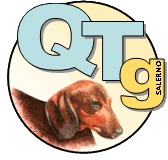|
Quantum Information
 Entanglement is one of the foundational properties of quantum
mechanics and an essential resource in quantum
communication and information processing. A crucial distinction must be made
between the tensor product structure of finite dimensional and infinite
dimensional Hilbert spaces, associated, respectively, to discrete and continuous
variables (CV). Understanding of CV entanglement poses major challenges. It is
important, to begin with, to select a class of CV states that be at the same
time amenable to analytical investigations and physically
relevant. Such a test ground is provided by the set of two-mode and multimode
Gaussian states. Entanglement is one of the foundational properties of quantum
mechanics and an essential resource in quantum
communication and information processing. A crucial distinction must be made
between the tensor product structure of finite dimensional and infinite
dimensional Hilbert spaces, associated, respectively, to discrete and continuous
variables (CV). Understanding of CV entanglement poses major challenges. It is
important, to begin with, to select a class of CV states that be at the same
time amenable to analytical investigations and physically
relevant. Such a test ground is provided by the set of two-mode and multimode
Gaussian states.
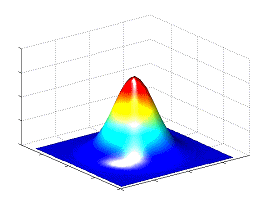 In this setting, we have developed an extended framework for the systematic
investigations of their bipartite
and multipartite entanglement properties. Among others, the main results
obtained so far include the discovery
of exact a priori upper and lower bounds on the bipartite entanglement of
two-mode mixed Gaussian states in terms
of the global and local degrees of purity, quantified by different types of
entropic measures.
The associated classes of maximally and minimally entangled mixed two-mode
Gaussian
states have been defined and their properties studied. These studies have been
extended to multimode states,
elucidating the scaling properties of bipartite entanglement with the number of
modes, and developing the concept
of unitarily localizable entanglement (under particular symmetry constraints).
We have addressed the sharing
structure of entanglement, proving new monogamy constraints that are the CV
generalization of the sharing
inequalities originally introduced for qubit systems. Although the structure of
monogamy inequalities, suitably adapted, still holds in Gaussian states of CV
systems, nevertheless, due to the profound differences between finite and
infinite dimensional state spaces, in the latter case entanglement sharing can
be promiscuous: there exist states of maximal symmetry between the modes, the so
called CV symultaneous GHZ/W
states that maximize both tripartite
entanglement (like in a GHZ state of qubits) and all couplewise correlations
when a mode is lost or traced out
(like in a W state of qubits). In this setting, we have developed an extended framework for the systematic
investigations of their bipartite
and multipartite entanglement properties. Among others, the main results
obtained so far include the discovery
of exact a priori upper and lower bounds on the bipartite entanglement of
two-mode mixed Gaussian states in terms
of the global and local degrees of purity, quantified by different types of
entropic measures.
The associated classes of maximally and minimally entangled mixed two-mode
Gaussian
states have been defined and their properties studied. These studies have been
extended to multimode states,
elucidating the scaling properties of bipartite entanglement with the number of
modes, and developing the concept
of unitarily localizable entanglement (under particular symmetry constraints).
We have addressed the sharing
structure of entanglement, proving new monogamy constraints that are the CV
generalization of the sharing
inequalities originally introduced for qubit systems. Although the structure of
monogamy inequalities, suitably adapted, still holds in Gaussian states of CV
systems, nevertheless, due to the profound differences between finite and
infinite dimensional state spaces, in the latter case entanglement sharing can
be promiscuous: there exist states of maximal symmetry between the modes, the so
called CV symultaneous GHZ/W
states that maximize both tripartite
entanglement (like in a GHZ state of qubits) and all couplewise correlations
when a mode is lost or traced out
(like in a W state of qubits).
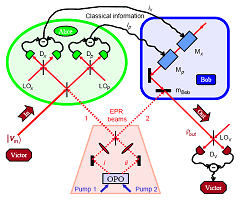 Another important point is the understanding of entanglement in connection with
the
operational aspects of quantum information, communication, and computation
processes. In the context of Gaussian
states of CV systems, we have shown that bipartite and multipartite
entanglements are operationally equivalent,
respectively, to the optimal success (maximal achievable fidelity at fixed local
squeezings) of two-user
CV quantum teleportation and multi-party CV teleportation networks. Studying Gaussian
states in action for concrete
protocols of quantum information, leads one naturally to study the interplay
between decoherence and
quantumness. Another important point is the understanding of entanglement in connection with
the
operational aspects of quantum information, communication, and computation
processes. In the context of Gaussian
states of CV systems, we have shown that bipartite and multipartite
entanglements are operationally equivalent,
respectively, to the optimal success (maximal achievable fidelity at fixed local
squeezings) of two-user
CV quantum teleportation and multi-party CV teleportation networks. Studying Gaussian
states in action for concrete
protocols of quantum information, leads one naturally to study the interplay
between decoherence and
quantumness.
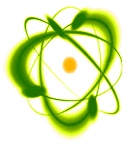 Considering the decoherence of Gaussian and non Gaussian states in
Gaussian noisy channels,
we have derived conditions on the initial states and on the noisy channel such
that the loss
of coherence is minimized at intermediate times with respect to the typical
relaxation time of the bath. Control and reduction of losses and decoherence play a crucial role in
discussing the generation of entanglement
itself. Considering the entanglement of material particles like atoms and
molecules, we have introduced an efficient,
quasi-deterministic scheme to generate maximally entangled states of two atomic
ensembles, based on quantum
non-demolition measurements of total atomic populations and on adiabatic quantum
feedback conditioned by
the measurement outputs. The high efficiency of the scheme has been tested and
confirmed numerically
for ideal photo-detection as well as in the presence of losses. Considering the decoherence of Gaussian and non Gaussian states in
Gaussian noisy channels,
we have derived conditions on the initial states and on the noisy channel such
that the loss
of coherence is minimized at intermediate times with respect to the typical
relaxation time of the bath. Control and reduction of losses and decoherence play a crucial role in
discussing the generation of entanglement
itself. Considering the entanglement of material particles like atoms and
molecules, we have introduced an efficient,
quasi-deterministic scheme to generate maximally entangled states of two atomic
ensembles, based on quantum
non-demolition measurements of total atomic populations and on adiabatic quantum
feedback conditioned by
the measurement outputs. The high efficiency of the scheme has been tested and
confirmed numerically
for ideal photo-detection as well as in the presence of losses.
 To realize an efficient quantum computer one must be able to store quantum data
efficiently.
We have proposed a new scheme to engineer quantum memories by techniques of
global quantum control,
introducing topologically time-modulated spin rings, with global and periodic
inversions of the
dynamics generated by residual interqubit interactions. This strategy inverts
and suppresses quantum diffusion, and allows the time-periodic reconstruction of
quantum information with perfect efficiency. Our approach allows the storage of
a large number (possibly macroscopic) of local quantum states, while being
intrinsically robust against several sources of noise and imperfections. To realize an efficient quantum computer one must be able to store quantum data
efficiently.
We have proposed a new scheme to engineer quantum memories by techniques of
global quantum control,
introducing topologically time-modulated spin rings, with global and periodic
inversions of the
dynamics generated by residual interqubit interactions. This strategy inverts
and suppresses quantum diffusion, and allows the time-periodic reconstruction of
quantum information with perfect efficiency. Our approach allows the storage of
a large number (possibly macroscopic) of local quantum states, while being
intrinsically robust against several sources of noise and imperfections.
Quantum Optics
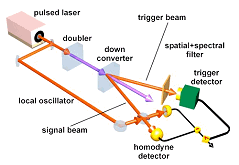 The exploitation of quantum and
nonclassical properties of multiphoton states of the electromagnetic field allows,
at least in principle, important applications in several branches of quantum physics, from quantum interferometry
to quantum communication and information. However, a major theoretical issue facing the community has been to
understand how to generalize to arbitrary numbers of photons and modes the structure of nonclassical states of
two-photon quantum optics, such as the two-photon squeezed states. The exploitation of quantum and
nonclassical properties of multiphoton states of the electromagnetic field allows,
at least in principle, important applications in several branches of quantum physics, from quantum interferometry
to quantum communication and information. However, a major theoretical issue facing the community has been to
understand how to generalize to arbitrary numbers of photons and modes the structure of nonclassical states of
two-photon quantum optics, such as the two-photon squeezed states.
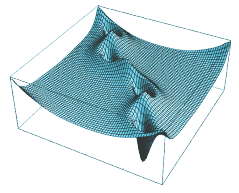 We have recently proposed a transparent and
rather general framework of canonical multiphoton quantum optics by introducing nonlinear, canonical and unitary,
generalizations of the linear Bogoliubov transformations. These transformations, nonlinear in the original modes,
but still associated to a linear, unitary mixing operator in Hilbert space, define generic multiphoton squeezed
states, in general non Gaussian, strongly nonclassical and entangled, that are realized by diagonalizable driving
multiphoton Hamiltonians. In principle, these multiphoton Hamiltonians are physically realizable, and we have
proposed an explicit experimental setup for the generation of
three-photon squeezed states. The method is based
on exploiting effective three-photon processes in nonlinear crystals with suitably enhanced third-order
nonlinearities and physical parameters. We have recently proposed a transparent and
rather general framework of canonical multiphoton quantum optics by introducing nonlinear, canonical and unitary,
generalizations of the linear Bogoliubov transformations. These transformations, nonlinear in the original modes,
but still associated to a linear, unitary mixing operator in Hilbert space, define generic multiphoton squeezed
states, in general non Gaussian, strongly nonclassical and entangled, that are realized by diagonalizable driving
multiphoton Hamiltonians. In principle, these multiphoton Hamiltonians are physically realizable, and we have
proposed an explicit experimental setup for the generation of
three-photon squeezed states. The method is based
on exploiting effective three-photon processes in nonlinear crystals with suitably enhanced third-order
nonlinearities and physical parameters.
|
